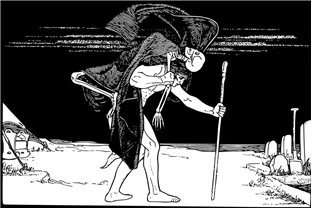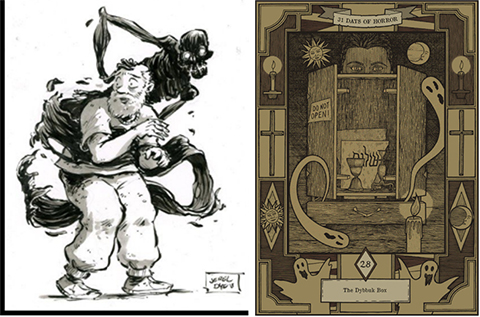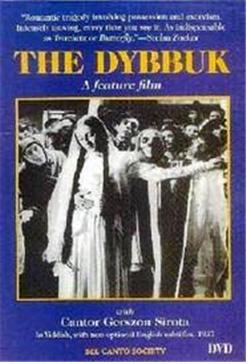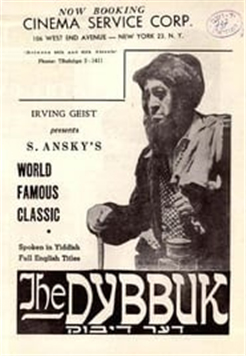 |
(1)
안철수가 연일 국민의힘을 향해 “후보 단일화하자”며 징징거리고 있다. 어머, 협박도 한다. “공연 시작을 기다리다 지친 관객들이 다 돌아가고 나면 뒤늦게 나훈아가 와도, 임영웅이 와도 흥행은 실패할 수밖에 없다.” 지금 히스테리 부리는 겨?
김종인은 비웃을 뿐이다. “너무나 서울시장 후보가 된다는 것에 집착하는 사람이 계속 몸이 달아하는 것 같은 모습을 보면 좀 안타깝긴 합니다잉…”
안철수가 뭐에 꽂히면 달라붙고 집착하고 캐릭터이긴 하다. 근데 몸 주고 마음 주면 실컷 이용해 먹고 떠난다. 이용가치가 없어지면 뒤도 안 돌아보고 저 혼자 철수해 방황하거나 달리기를 한다. 이게 안철수의 주특기다. 이런 일이 반복되다보니 안철새는 분열의 아이콘이 되고 말았다.
 |
(2)
유대인들이 기겁하는 ‘방황하는 망령’이 있는데 안철수를 참 많이 닮았다. 무엇이 무엇이 닮았으까.
이 망령은 달라붙는 놈이다. 자신의 이름에도 ‘달라붙는다’는 의미를 오롯이 담아낸 놈이니 대단하다. 이 망령은 사람을 쪽 빨아먹은 뒤, 실컷 이용해 먹은 뒤, 자신의 목적을 이룬 뒤 떠난다.
정신의학계에서는 이 망령이 히스테리와 모종의 관계가 있다고 추정한다. 또 흥행업계에서는 이 망령이 흥행에 관심이 많다고 증언하고 있다. 실제 놈은 수없이 많은 영화에 출연했다. 노래에도 등장한다.
 |
(부록)
방황하는 망령
dāḇaq(영어로는 디벅, dybbuk). 유태인이 믿는 ‘죽은 자의 망령’. a malicious possessing spirit believed to be the dislocated soul of a dead person. a restless spirit believed to be able to haunt and even possess the living.
이름풀이 해보니...
달라붙는 놈 ; Dybbuk comes from the Hebrew word דִּיבּוּק dibbūq which means 'the act of sticking' and is a nominal form derived from the verb דָּבַק dāḇaq 'to adhere' or 'cling'.
분열-분할돼 나온 놈 ; a cleavage of an evil spirit.
날아온 돌 ; dibbuk from the outside.
 |
이용해먹곤 떠나
It supposedly leaves the host body once it has accomplished its goal, sometimes after being helped.
정신의학적으로는....
히스테리와 관계 있음. In psychological literature the dybbuk has been described as a hysterical syndrome.
 |
흥행의 주인공
◾음악계 진출 ; In March 2020, the horror punk band Voice of Doom released the song The Dybbuk on the album Horror Punks USA Quarantine Compilation 2020, Volume 1.
◾영화계 진출 : Michał Waszyński's 1937 film The Dybbuk, based on the Yiddish play by S. Ansky, is considered one of the classics of Yiddish film-making. In Love and Death, Woody Allen's 1975 satire of Russian literature, Boris (Allen) flirts with the Countess Alexandrovna (Olga Georges-Picot), who is attending an opera with her lover Anton Ivanovich Lebedokov (Harold Gould). When the Countess says to Boris "You must visit me for tea. I'm sure we'd have a lot to talk about," Boris says "What about the dybbuk?"
In the 1997 Christopher Guest film Waiting for Guffman, dentist Allan Pearl discusses his family history with show business: "I think I got a, a, an entertaining bug... from my grandfather... uh, Chaim Pearlgut, who was very very big in the, um, Yiddish, uh, theater, back in New York. He was in the, the very... the sardonically irreverent ..."Dybbuk Shmybbuk, I Said 'More Ham'"... and that revue I believe was 1914, and that revue was what made him famous. Incidentally, the song 'Bubbe Made a Kishke' came from that revue."
The dybbuk was featured as the main antagonist in the horror films The Unborn (2009), The Possession (2012) and Ezra.
A Serious Man opens with a parable about a couple who suspect that the rabbi they are hosting for dinner is a dybbuk.
Marcin Wrona's Demon is the story of a groom possessed by a dybbuk the night before his wedding.
The Malayalam film Ezra (2017) revolves around a dybbuk box, with references to Kabbalist traditions and occultism. In the film To Dust (2018) the protagonist is suspected by his children to be possessed by a dybbuk.
The dybbuk was also the main antagonist in the short film Dibbuk (2019) directed by Dayan D. Oualid. The film deals with an exorcism within the Parisian Jewish community.
The dybbuk was mentioned in the film Killer Sofa (2019) about a killer recliner possessed by a dybbuk.
 |
◾Print ; In Romain Gary's 1967 novel The Dance of Genghis Cohn, a concentration camp warden is haunted by the dybbuk of one of his victims.
In Ellen Galford's 1993 novel The Dyke and the Dybbuk, lesbian taxi-driver Rainbow Rosenbloom is haunted by, and gets the better of, a female dybbuk haunting her as a result of a curse placed on her ancestor 200 years ago.
The dybbuk appears in the novel, The Inquisitor's Apprentice (2011) by Chris Moriarty.
In the comic series Girl Genius, the forcible insertion of the mind of Agatha's mother, the main villain Lucrezia Mongfish/"The Other", into her own was compared to a dybbuk by one of her followers when reporting the situation to someone else.
Richard Zimler's 2011 novel The Warsaw Anagrams is narrated by a dybbuk desperately trying to understand why he has remained in our world. This is in keeping with kabbalistic belief that dybbuks fail to pass over to the Other Side because of a mitzvah or duty that they have failed to fulfil.
◾Television ; Sidney Lumet directed "The Dybbuk", an episode of The Play of the Week based on the play by S. Ansky adapted into English by Joseph Liss. It aired on October 3, 1960.
The dybbuk is mentioned in the paranormal TV show Paranormal Witness, season 2, episode 4, "The Dybbuk Box" (USA 2012). In the TV show Difficult People, season 3, episode 3 "Code Change", Billy helps his sister-in-law Rucchel exorcise what she believes to be a dybbuk from her basement. 너무 길어서 이하 생략.
관리자 freemediaf@gmail.com
<저작권자 © 자유언론실천재단, 무단 전재 및 재배포 금지>

